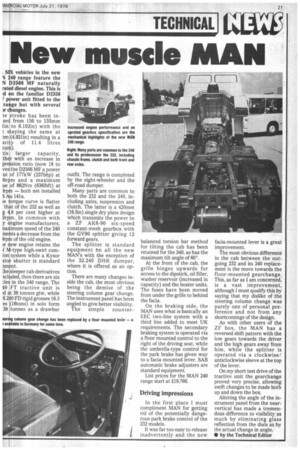New muscle MAN
Page 23

If you've noticed an error in this article please click here to report it so we can fix it.
, SIX vehicles in the new ✓ 240 range feature the N D2566 MF naturally rated diesel engine. This is d on the familiar D2556 7 power unit fitted to the range but with several w changes.
le stroke has been insec from 150 to 155mm lin to 6.102in) with the staying the same at im (4.921in) resulting in a ici :y of 11.4 litres cuin).
us larger capacity, ther with an increase in pression ratio (now 18 to yes the D2566 MF a power ut of 177kW (237bhp) at Orpm and a maximum ue of 862Nm (6361bft) at )rpm — both net installed 3 Au 141a.
Le torque curve is flatter thitt of the 232 as well as g 4.8 per cent higher at Drpm. In common with y engine manufacturers, naximum speed of the 240 .,.sents a decrease from the Irpm of the old engine.
Le new engine retains the M-type high-swirl cornion system while a Kysor Itor shutter is standard
3ment.
:he sleeper cab derivatives ncluded, then there are six les in the 240 range. The 40 FT tractive unit is !d at 38 tonnes gtw, while 6.240 FD rigid grosses 16.3 es (I6tons) in solo form 38 tonnes as a drawbar . outfit. The range is completed by the eight-wheeler and the off-road dumper.
Many parts are common to both the 232 and the 240, including axles, suspension and clutch. The latter is a 420mm (16.5in) single dry plate design which transmits the power to a ZF AK6-90 six-speed constant-mesh gearbox with the GV90 splitter giving 12 forward gears.
The splitter is standard equipment bn all the new MAN's with the exception of the 32.240 DHK dumper, where it is offered as an option.
There are many changes inside the cab, the most obvious being the demise of the steering column gear change. The instrument panel has been angled to give better visibility.
The simple counter balanced torsion bar method for tilting the cab has been retained for the 240, as has the maximum tilt angle of 60°.
At the front of the cab, the grille hinges upwards for access to the dipstick, oil filler, washer reservoir (increased in capacity) and the heater units. The fuses have been moved from under the grille to behind the facia.
On the braking side, the MAN uses what is basically an EEC two-line system with a third line added to meet UK requirements. The secondary braking system is operated via a floor mounted control to the right of the driving seat, while the umbrella-type control for the park brake has given way to a facia mounted lever. SAB automatic brake adjusters are standard equipment.
List prices for the MAN 240 range start at £19,766.
Driving impressions
In the first place I must compliment MAN for getting rid of the potentially dangerous park brake control of the 232 models.
It was far too easy to release inadvertently and the new facia-mounted lever is a great improvement.
The most obvious difference in the cab between the outgoing 232 and its 240 replacement is the move towards the floor-mounted gearchange. This, as far as I am concerned, is a vast improvement, although I must qualify this by saying that my dislike of the steering column change was purely one of personal preference and not from any shortcomings of the design.
As with other users of the ZF box, the MAN has a reversed shift pattern with the low gears towards the driver and the high gears away from him, while the splitter is operated via a clockwise/ anticlockwise sleeve at the top of the lever.
On my short test drive of the tractive unit the gearchange proved very precise, allowing swift changes to be made both up and down the box.
Altering the angle of the instrument panel from the nearvertical has made a tremendous difference to visibility as much by eliminating glass reflection from the dials as by the actual change in angle.
• by the Technical Editor




































































































